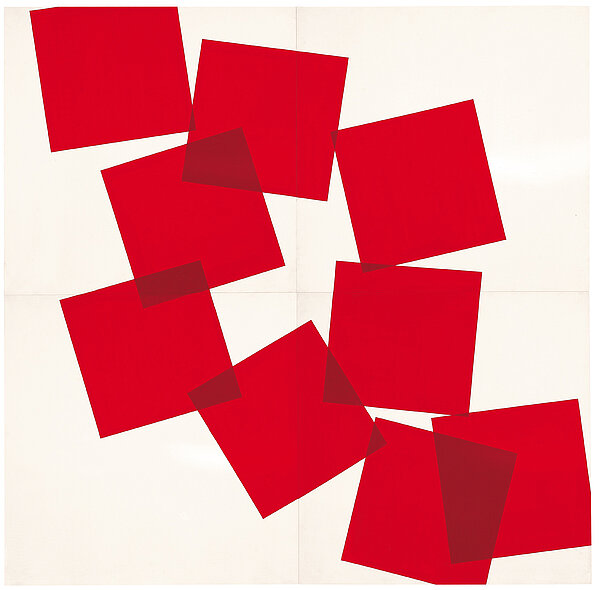Vera Molnar
9 carrés dispersés par le vent du large, 1999/2001
Acrylic on canvas, 4 parts
200 x 200 cm
© VG Bild-Kunst, Bonn 2022
Photo: Gerhard Sauer
The works of Vera Molnar are among the most original and novel to have been produced to date under the banner of geometric abstraction in Europe. Not only does the artist distinguish herself by constantly exploring new paths – she was one of the very first to use a computer for her art – she is also one of the few who have grasped the rational principles of geometrical art to such an extent that she can actually dispense with them.
“Art is an error in the system” – this remark by Paul Klee is one that Vera Molnar has taken to heart, and works such as 9 carrés dispersés par le vent du large show that one can only implement these errors as and when one has mastered the system. Nine brilliant red squares which measure 50 cm on each side have been loosely distributed about a diagonal across four white square canvases measuring 100 cm on each side, which form in turn a square measuring 200 cm on each side. So if one gives the side length of one of the red squares as the basic module the value of 1, the overall painting can be delineated by the powers of two – by 1, 2, 3, 4 – as the determining factors for each of the various surfaces. But as hinted at by the title, which may approximately be translated as “9 squares scattered far and wide by the seawind”, the art in this painting arises when a neat and tidy order based on numerals is disrupted. Because while the choice of the elements has been done according to strict rules, the distribution of the red squares has been performed by chance. The impression of disorder is further intensified here inasmuch as the areas where the red surfaces overlap have been done in a different shade and with that form triangles and rectangles, which come as something of a disruption to the harmonious squareness of the work. That this disarray does not lapse in turn into chaos but maintains a precarious balance with the initial order is the decisive factor in this work – a factor around which Molnar’s artistic output revolves.
Vera Molnar admits that the road to accepting such chance compositions was a very long one indeed. Setting out with an unconditional faith in systematics in art, for several decades she pursued artistic research into the organization of the painting and, with the aid of the computer, discovered that the rational laws of geometry and mathematics could never be an adequate basis for artistic works and that the beauty of a geometrical composition similarly lies outside of geometry itself. But what this in fact depends on and whether indeed it will prove possible to determine this, must be left to her future researches. (Andreas Pinczewski)
Vera Molnar
1924 born in Budapest
2023 died in Paris


